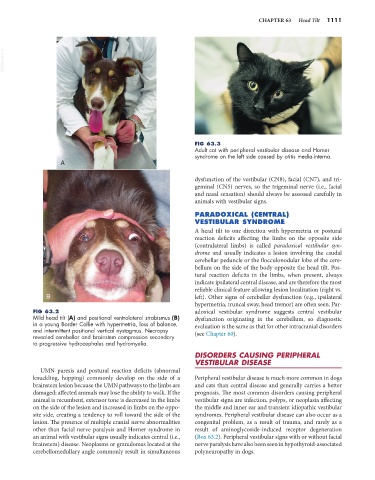Page 1139 - Small Animal Internal Medicine, 6th Edition
P. 1139
CHAPTER 63 Head Tilt 1111
VetBooks.ir
FIG 63.3
Adult cat with peripheral vestibular disease and Horner
syndrome on the left side caused by otitis media-interna.
A
dysfunction of the vestibular (CN8), facial (CN7), and tri-
geminal (CN5) nerves, so the trigeminal nerve (i.e., facial
and nasal sensation) should always be assessed carefully in
animals with vestibular signs.
PARADOXICAL (CENTRAL)
VESTIBULAR SYNDROME
A head tilt to one direction with hypermetria or postural
reaction deficits affecting the limbs on the opposite side
(contralateral limbs) is called paradoxical vestibular syn-
drome and usually indicates a lesion involving the caudal
cerebellar peduncle or the flocculonodular lobe of the cere-
bellum on the side of the body opposite the head tilt. Pos-
tural reaction deficits in the limbs, when present, always
indicate ipsilateral central disease, and are therefore the most
reliable clinical feature allowing lesion localization (right vs.
B left). Other signs of cerebellar dysfunction (e.g., ipsilateral
hypermetria, truncal sway, head tremor) are often seen. Par-
FIG 63.2 adoxical vestibular syndrome suggests central vestibular
Mild head tilt (A) and positional ventrolateral strabismus (B) dysfunction originating in the cerebellum, so diagnostic
in a young Border Collie with hypermetria, loss of balance, evaluation is the same as that for other intracranial disorders
and intermittent positional vertical nystagmus. Necropsy
revealed cerebellar and brainstem compression secondary (see Chapter 60).
to progressive hydrocephalus and hydromyelia.
DISORDERS CAUSING PERIPHERAL
VESTIBULAR DISEASE
UMN paresis and postural reaction deficits (abnormal
knuckling, hopping) commonly develop on the side of a Peripheral vestibular disease is much more common in dogs
brainstem lesion because the UMN pathways to the limbs are and cats than central disease and generally carries a better
damaged; affected animals may lose the ability to walk. If the prognosis. The most common disorders causing peripheral
animal is recumbent, extensor tone is decreased in the limbs vestibular signs are infection, polyps, or neoplasia affecting
on the side of the lesion and increased in limbs on the oppo- the middle and inner ear and transient idiopathic vestibular
site side, creating a tendency to roll toward the side of the syndromes. Peripheral vestibular disease can also occur as a
lesion. The presence of multiple cranial nerve abnormalities congenital problem, as a result of trauma, and rarely as a
other than facial nerve paralysis and Horner syndrome in result of aminoglycoside-induced receptor degeneration
an animal with vestibular signs usually indicates central (i.e., (Box 63.2). Peripheral vestibular signs with or without facial
brainstem) disease. Neoplasms or granulomas located at the nerve paralysis have also been seen in hypothyroid-associated
cerebellomedullary angle commonly result in simultaneous polyneuropathy in dogs.

